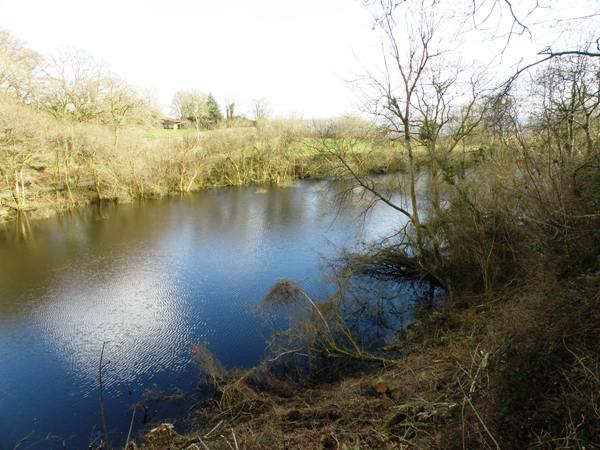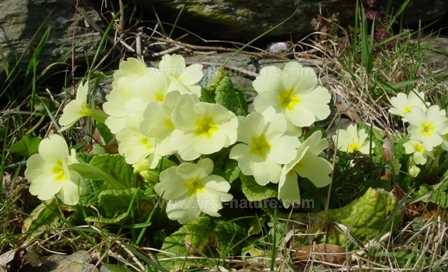Carmel Woods National Nature Reserve, Llandeilo, Carmarthenshire, South Wales
Designations: Carmel Woods is part of the Cernydd Carmel SSSI and SAC
Below: The entrance to Carmel Woods NNR

This NNR is home to the only turlough (seasonal lake) in Britain, but it has many other habitats and wildlife to enjoy, too. Apart from broad-leaved woodland, Carmel Woods has heathland, bog, a limestone quarry, caves and species-rich grassland.
The type of woodland in this reserve is predominantly Ash trees on limestone, which is uncommon in European countries other than Britain. Here, due to the high rainfall, such woodlands can be found in southwestern parts of Scotland, in the Peak and Lake districts, and further south in the Mendips. In Wales there are examples in both the south and the north.
The site is managed by the Wildlife Trust of South and West Wales and Natural Resources Wales (NRW).
Directions
Grid Ref: SN 602165
Despite having several entrances, access to this nature reserve can take a frustratingly long time to find. Carmel Woods lies off the main A476 Llandeilo to Llanelli road, and to find the main entrance, which has a small car park and a picnic area, it is best to aim for the village of Pentre Gwenlais where the entrance is situated on a T-junction less than 1/2km (500yds) north of the village. For those travelling by car, there is also some parking available in the village in the event of the nature reserve car park being full.
Access
There are good tracks throughout the NNR, but some of them are steep, rocky and rutted and therefore not suitable for wheelchair users. There is a circular walk from the main entrance around the old quarry, but this can be particularly slippery in winter or at any time of year during or just after heavy rain.
Below: The turlough (seasonal lake) at Carmel Woods NNR

Facilities
There are no facilites at the reserve apart from information boards. There are shops and pubs in the surrounding villages.
Description of Site
Because of our wide interest in wildlife we enjoy walking in nature reserves at any time of the year, but if you love the spirit-lifting effect of spring there is no finer place to walk in springtime than a woodland, and Carmel Woods is a particularly good example.
Early Primroses Primula vulgaris and Lesser Celandine Ficaria verna light up the path edges from the end of February, and the birdsong is an absolute joy. This reserve is home to many kinds of woodland birds, and the turlough is a welcome refuge for wildfowl during the winter months.
Unless you have spent time in Ireland (and in The Burren, in particular, where there are several) you will not be familiar with turloughs - seasonal lakes. These lakes fill up with water in late Autumn and dry out completely during the following summer. In the case of Pant y Llyn, the turlough at Carmel Woods, the depth in winter can be up to 3 metres. The lake has neither inlet nor outlet streams; it is fed entirely by ground water governed by the local water table.
The floor of the basin is covered by bryophytes (non-vascular plants) of which the two dominant species are Fontinalis antipyretica and Drepanocladus aduncus. Also present is Swamp Horsetail Equisetum fluviatile and Bladder Sedge Carex vesicaria. Living in the lake is a range of animals and insects. Frogs, newts and toads occur in large numbers, and the insects include several kinds of aquatic beetles that feed on the wealth of minute invertebrates that co-exist in the water.
Below: Primroses light up the woodland in early spring

Studies in Carmel Woods reveal that there are over 100 species of indigenous woodland plants, and a similar number of mosses living there. Some parts of the woodland, which has been in existence since the Middle Ages, are coppiced in order to encourage the growth of wildflowers that need more light, but other parts are managed on a 'minimal intervention' basis and left purely to nature's own management system.
There are some unusual woodland plants in Carmel Woods including Mezereon Daphne mezereum, Toothwort Lathraea squamaria, Lily-of-the-valley Convallaria majalis and Herb Paris Paris quadrifolia.
Ash is the dominant tree species in the woods but there are also Dogwood Cornus sanguinea, Buckthorn (Rhamnus cartharticus), Spindle Euonymus europeaeus, Hazel Corylus avellana and Hawthorn Cratageus monogyna. The 'shrubby' nature of some of these trees makes Carmel Woods an ideal home for Dormice, which are particularly fond of Hazel nuts.
Buckthorn is the food of the Brimstone Butterfly Gonepteryx rhamni, and so these lovely insects can be seen in the sunny clearings in spring and late summer. In the deep shade the rare Harvest Spider Sabacon viscayanum lives in the thick carpets of moss and leaf litter. Apart from a few locations in Wales this spider is otherwise known only from parts of the Pyrenees in southern Europe; it keeps good company, because also found in similar humus beneath Hazels is Yellow Bird's-nest Monotropa hypopitys.
Some of the grassland parts of the reserve are under a managed grazing regime, and as a result, support numerous grassland species of wildflowers including Common Knapweed Centaurea nigra and Bird's-foot Trefoil Lotus corniculatus. The Greater Butterfly Orchid Platanthera chlorantha grows there, too. These flowers, in turn, support several uncommon insects including the Pearl-bordered Fritillary butterfly (Boloria Euphrosyne).
The caves in the woods are home to bats, including the now very rare Greater Horseshoe Bat Rhinolophus ferrumequinium. The high humidity in the woods ensures that there is a ready supply of insects for them to feed on.
In autumn fungi are in the ascendancy throughout the reserve. In the grassland, the flowers are succeeded by mushrooms that are just as colourful. Waxcaps, sometimes referred to as the orchids of the fungus world because of their bright colours, are one of the notable fungi families that can be seen in Carmel Woods NNR.